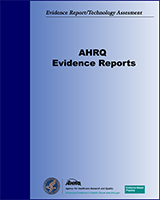NCBI Bookshelf. A service of the National Library of Medicine, National Institutes of Health.
This publication is provided for historical reference only and the information may be out of date.
Structured Abstract
Objectives:
This report describes evidence about the clinical assessment and management of patients presenting with acute exacerbation of chronic obstructive pulmonary disease, a frequent cause of health care utilization, mortality, and decreased quality of life.
Search Strategy:
Databases searched were MEDLINE (from 1966 to June 1999), EMBASE (from 1974 to February 1999), and the Cochrane Controlled Trials Register (1998 Issue 4). Search strategies included index terms and text words for “chronic obstructive pulmonary disease” and “acute exacerbation,” and specific terms relating to interventions and methodology.
Selection Criteria:
The population of interest was the adult with chronic obstructive pulmonary disease (based on clinical diagnosis, spirometry, or known or suspected history) with an acute exacerbation of respiratory symptoms (increasing dyspnea, sputum quantity, or sputum purulence; or acute respiratory failure). Interventions considered were clinical assessment (including history and physical examination), antibiotics, bronchodilating drugs, corticosteroids, mucolytic drugs, chest physiotherapy, and noninvasive positive pressure ventilation. For efficacy of therapeutic interventions, only randomized and other prospective controlled trials were considered. Data on adverse effects were obtained from these trials and from additional cohort studies and case series. For clinical assessment, retrospective and prospective cohort studies and case series were considered. Outcomes of interest were ventilatory function and respiratory symptoms, short-term mortality, and health services utilization.
Data Collection and Analysis:
At least two reviewers independently screened citations; references included by either rater were retained. Full reports were reevaluated according to the selection criteria and data describing study population, study design, interventions, and outcomes. Quality was assessed based on criteria related to external validity (characterization of the study population) and internal validity.
Main Results:
Acute clinically significant abnormalities on chest roentgenography (e.g., evidence of infiltrate or pulmonary edema) are common in patients presenting with acute exacerbation of chronic obstructive pulmonary disease, but they are not well predicted by history or physical examination. Data on acute respiratory physiology, baseline pulmonary status, general health status, and past response to treatment were predictive of treatment failure, short-term mortality, and the need for mechanical ventilation in patients with acute exacerbation of chronic obstructive pulmonary disease. Together, all types of data were only moderately predictive of short-term prognosis. Antibiotics, beta2-agonists, anticholinergic bronchodilating drugs, and corticosteroids demonstrated benefit. Methylxanthines were associated with high risk of toxicity. Mucolytic drugs and chest physiotherapy were not shown to be effective. In patients with acute respiratory failure, noninvasive positive pressure ventilation compared with conservative management reduced mortality and the need for endotracheal intubation and mechanical ventilation. Noninvasive positive pressure ventilation compared with mechanical ventilation led to reduced mortality and fewer complications. The literature is limited by the lack of agreement on a precise definition of acute exacerbation and by the lack of a consistent scale for grading the severity of exacerbations.
Conclusions:
Although many factors are associated with poor outcomes in patients with acute exacerbation of chronic obstructive pulmonary disease, it is not possible to formulate accurate, clinically useful predictions concerning patients' prognoses. Hence, ongoing clinical monitoring is necessary for many patients. Several conservative therapies utilized for the management of acute exacerbation show benefit (antibiotics, corticosteroids, and bronchodilators); however, some therapies lack evidence of efficacy (mucolytics and physical therapy). The more aggressive strategy of noninvasive positive pressure ventilation benefits some patients with acute exacerbation of chronic obstructive pulmonary disease and acute respiratory failure.
Contents
Prepared for: Agency for Healthcare Research and Quality, U.S. Department of Health and Human Services.1 Contract No. 290-97-0014. Prepared by: Duke University Evidence-based Practice Center, Center for Clinical Health Policy Research.
Suggested citation:
McCrory DC, Brown C, Gray RN, et al. Management of Acute Exacerbations of COPD. Evidence Report/Technology Assessment No. 19 (Contract 290-97-0014 to the Duke University Evidence-based Practice Center). AHRQ Publication No. 01-E003. Rockville (MD): Agency for Healthcare Research and Quality. March 2001.
On December 6, 1999, under Public Law 106-129, the Agency for Health Care Policy and Research (AHCPR) was reauthorized and renamed the Agency for Healthcare Research and Quality (AHRQ). The law authorizes AHRQ to continue its research on the cost, quality, and outcomes of health care and expands its role to improve patient safety and address medical errors.
This report may be used, in whole or in part, as the basis for development of clinical practice guidelines and other quality enhancements tools, or a basis for reimbursement and coverage policies. AHRQ or U.S. Department of Health and Human Services endorsement of such derivative products may not be stated or implied.
The authors of this report are responsible for its content. Statements in the report should not be construed as endorsement by the Agency for Healthcare Research and Quality or the U.S. Department of Health and Human Services of a particular drug, test, treatment, or other clinical service.
- 1
2101 East Jefferson Street, Rockville, MD 20852. www
.ahrq.gov
